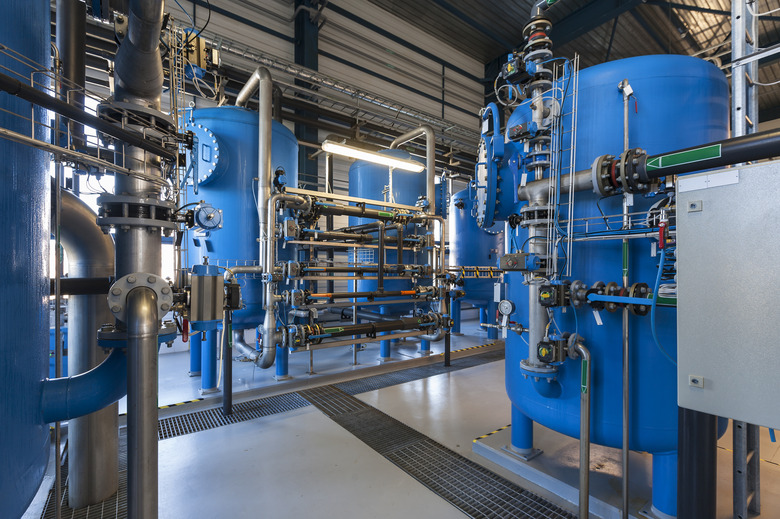How To Remove Chlorine From Water
Water treatment for health and safety is usually done with chlorine because chlorine kills microorganisms that are responsible for waterborne diseases like typhoid fever and cholera. But some water uses, such as aquarium-keeping or home brewing, require chlorine-free water and many people prefer to drink water without the distinctive chlorine aroma and flavor.
Remove Chlorine by Evaporation
Remove Chlorine by Evaporation
The simplest way to remove chlorine is to simply let it evaporate from the water. Chlorine is a gas at room temperature, and in water it's a "volatile solute" meaning its molecules are diffused in the water, and it will escape into the air over time. The amount of time needed varies with air and water temperature. Heating or boiling the water will speed the process. Another factor is the amount of surface area for the volume of water; a wide-mouth container will allow the chlorine to dissipate more quickly because it exposes more of the water's surface to the air. This method will only remove chlorine, though, and many modern water treatment systems use chloramines. You cannot rely on evaporation to remove chloramines, so if you are changing a fish bowl, check with your water department to see if they use chloramines. If they do, you will need to use a different method to ensure safe water for your fish.
Remove Chlorine by Filtration
Remove Chlorine by Filtration
Chlorine can be removed by running the water through a filter with activated charcoal, in granular or particle form. The carbon works by adsorption, the molecular bonding of the chlorine ions to the surface of the charcoal. According to the Minnesota Department of Health, it's important to size the filter(s) appropriately for the amount of water to be treated, and the charcoal must be replaced periodically. Another filtering method is kinetic degradation fluxion: using a copper-zinc alloy to convert free chlorine to chloride through oxidation. To remove chloramine, an extensive carbon filter (to remove the chlorine part of the chloramine molecule) followed by a reverse osmosis or cation filter (to remove the ammonia) is necessary.
Remove Chlorine Through Chemical Neutralization
Remove Chlorine Through Chemical Neutralization
Several chemical compounds can remove chlorine from water. Some, like sulfur dioxide, are toxic and dangerous to handle. Others, like ascorbic acid, or vitamin C, are safer, or even edible. Other options include sodium thiosulfate, sodium sulfite, or sodium bisulfite. The resulting by-products vary, and in some cases — discharging dechlorinated water into streams, for example — environmental regulations may apply because of consequences like reduced dissolved oxygen in receiving streams. This is called "oxygen scavenging." Again, if you are trying to purify your water for applications like fish tanks, check if your drinking water is treated with chloramines, and if so, you will need different chemicals for neutralization.
Remove Chlorine dioxide
Remove Chlorine dioxide
Chlorine dioxide is a water additive used to control microbes and can be used to control tastes and odors. It rapidly disappears from stored water.
References
- Scientific American: How Does Chlorine Added to Drinking Water Kill Bacteria and Other Harmful Organisms? Why Doesn't it Harm Us?
- Journal of Chemical Education: The Rates of Evaporation of Chlorine, Bromine and Iodine From Aqueous Solutions
- Minnesota Department of Health: Water Treatment Using Carbon Filters: GAC Filter Information
- Integra Chemical: Guidance Manual for Disposal of Chlorinated Water
- Basic Information about Disinfectants in Drinking Water: Chloramine, Chlorine and Chlorine Dioxide
- Citizens Concerned about Chloramine
Cite This Article
MLA
Silbajoris, Alex. "How To Remove Chlorine From Water" sciencing.com, https://www.sciencing.com/remove-chlorine-from-water-4516999/. 25 April 2018.
APA
Silbajoris, Alex. (2018, April 25). How To Remove Chlorine From Water. sciencing.com. Retrieved from https://www.sciencing.com/remove-chlorine-from-water-4516999/
Chicago
Silbajoris, Alex. How To Remove Chlorine From Water last modified March 24, 2022. https://www.sciencing.com/remove-chlorine-from-water-4516999/
